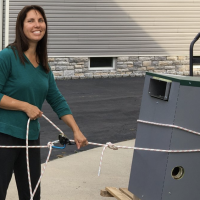Chimney Liner- SS or Ti?
As I explore liners I see 2 material choices. SS or Ti.
Thoughts on which one? It c would be for NG boiler.
Comments
-
-
the manufacturers requirements are best.
0 -
Ti is not a titanium liner. It is stainless steel/titanium alloy.
316Ti (UNS S31635) is a titanium stabilised version of 316 molybdenum-bearing austenitic stainless steel. The 316 alloys are more resistant to general corrosion and pitting/crevice corrosion than the conventional chromium-nickel austenitic stainless steels such as 304. They also offer higher creep, stress-rupture and tensile strength at elevated temperature. High carbon Alloy 316 stainless steel can be susceptible to sensitisation, the formation of grain boundary chromium carbides at temperatures between approximately 900 and 1500°F (425 to 815°C) which can result in intergranular corrosion.
Resistance to sensitisation is achieved in Alloy 316Ti with titanium additions to stabilise the structure against chromium carbide precipitation, which is the source of sensitisation. This stabilisation is achieved by an intermediate temperature heat treatment, during which the titanium reacts with carbon to form titanium carbides. This significantly reduces susceptibility to sensitisation in service by limiting the formation of chromium carbides. Thus, the alloy can be used for extended periods at elevated temperatures without compromising its corrosion resistance. 316Ti has equvilent corrosion resistance to sensitisation as the low carbon version 316L.
4 -
-
Yellowdog,thanks for clarifying this! So I am thinking that 316L Stainless Steel will be fine.
0 -
316Ti is the most common alloy in liners currently. It can be used for CAT I gas, oil, wood and even coal (if hard, low sulfur).
316L is also used for heavier wall flex liners and smoothwall. It's also a little easier to drill. Don't use plain old 304 for gas- it does not possess the corrosion resistance needed. Same for most 400 series of stainless. There are some proprietary super ferritic alloys that perform well in hostile environments.
Type AL29-4c is too stiff to make into liner but performs well as rigid liner. It is used for CAT IV condensing gas appliances and pellet stoves.
The intergranular corrosion Yellowdoggie referred to is really only a problem with a creosote fire from wood burning. Otherwise, you're pretty much under those temps.
1 -
Either one. But with this type of thing I defer to the manufacturers suggestion. Its the safest best bet.
0 -
Categories
- All Categories
- 87.3K THE MAIN WALL
- 3.2K A-C, Heat Pumps & Refrigeration
- 61 Biomass
- 427 Carbon Monoxide Awareness
- 119 Chimneys & Flues
- 2.1K Domestic Hot Water
- 5.8K Gas Heating
- 115 Geothermal
- 165 Indoor-Air Quality
- 3.7K Oil Heating
- 76 Pipe Deterioration
- 1K Plumbing
- 6.5K Radiant Heating
- 395 Solar
- 15.6K Strictly Steam
- 3.4K Thermostats and Controls
- 56 Water Quality
- 51 Industry Classes
- 50 Job Opportunities
- 18 Recall Announcements




